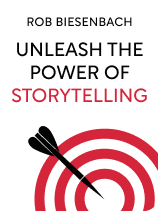

This article is an excerpt from the Shortform book guide to "Unleash the Power of Storytelling" by Rob Biesenbach. Shortform has the world's best summaries and analyses of books you should be reading.
Like this article? Sign up for a free trial here.
What makes a story a story? What does your audience expect from your narrative?
In his 2018 book Unleash the Power of Storytelling, speechwriter-turned-actor Rob Biesenbach asserts that you can make any message much more compelling by simply telling a story. Whether you’re writing a novel or preparing a toast, you can learn from his advice.
Keep reading to learn the three necessary components of a story, no matter what your message is.
The Essential Components of a Story
We encounter stories every day, but few of us stop to think about how we’d define a story. A story is a narrative that draws its power from its fundamental structure, its delivery, and its ability to affect listeners down to the neural level. We’ll look at what Biesenbach identifies as the essential components of a story.
Biesenbach defines a story as an account of a character who pursues a goal and encounters obstacles along the way. A narrative that lacks one of these fundamental components of a story (character, goal, and obstacle) isn’t a story and won’t affect listeners like a story can. Because we’re familiar with stories that include a character, a goal, and obstacles, we expect these elements in a story and feel disappointed when those expectations aren’t met.
The character’s efforts in the face of obstacles drive the story forward. A relatable character—one who shares values or circumstances with your audience—makes an abstract brand, mission, or message more concrete. Every story needs a character who embodies the message and makes it more human to listeners.
For example, the knitwear brand babaà—which makes the cult-favorite cardigan a New Yorker writer spotted on “organic moms” across Instagram—tells a story about how it makes its sweaters with local materials and artisans. When the brand names the shepherds who tend its sheep and the knitters who run its factory, these people become characters in the story. They make the company feel more relatable because we can understand working in a family-run workshop or carrying on a traditional craft, even if we haven’t done those things ourselves.
| How a Character Changes How We See Things Biesenbach’s definition of a story might surprise you if you think of a story as a plotline or a series of events, but he’s not alone in putting more emphasis on characters than plotlines when articulating what makes a story a story. In Wired for Story, Lisa Cron offers her own definition: “A story is how what happens affects someone who is trying to achieve what turns out to be a difficult goal, and how he or she changes as a result.” Cron explains that though we tend to think that a story is about events, it’s really about the character’s response to those events. In fact, she thinks that the external events of the story—like the obstacles that Biesenbach talks about—only matter insofar as they push the character into an internal struggle. During that struggle, the character realizes that something important is at stake—this relates to the goal that Biesenbach explains your character must have—and that they have to act. You ask your listeners to follow along with what your character is doing and thinking to change what your listeners do and think. Cron believes that the entire purpose of a story is to change how your audience sees things. After all, once you change how they see things, the members of your audience are more likely to be willing to change how they do things. |
Exercise: Find the Message for Your Story
One of the biggest lessons of Unleash the Power of Storytelling is that a story provides you with a powerful way to convey a message. But before you can choose the right story, you’ll need to figure out the message you want to share.
- Most of us are great at talking about ourselves. So to practice, think about the message you’d like listeners to come away with the next time you introduce yourself—a message about who you are or why you do what you do. Write that message down here.
- Now try to think of that message in terms of a story. Think of yourself as a character: What is your goal? What are the obstacles that you encounter when trying to reach that goal? Write down your goals and obstacles here.
- Think about what your listener might find relatable about you as a character. Which of your values are universal, or what situation do you find yourself in that others have also experienced? (The things you have in common with your listener are things you’ll want to emphasize when you create your story.)

———End of Preview———
Like what you just read? Read the rest of the world's best book summary and analysis of Rob Biesenbach's "Unleash the Power of Storytelling" at Shortform.
Here's what you'll find in our full Unleash the Power of Storytelling summary:
- How telling a story can make any message more compelling
- The unique power stories have to influence us and shape our emotions
- The crucial pieces that make up a story (other than the beginning, middle, and end)






